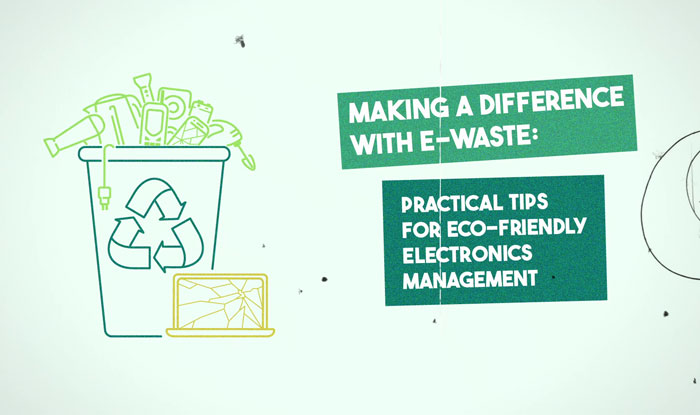Practical Tips for Eco-Friendly Electronic Waste Management

In 2021, the world produced a sickening amount of 57.4 million metric tons of e-waste.
On paper, it’s just a number. Rolls right off the tongue, and doesn’t leave a bad taste in your mouth. And why should it? An average person cannot instantly grasp just how monstrously massive this number is.
But allow me to help you visualize that. 57.4 million metric tons is:
- Roughly equivalent to around 157 times the weight of the Empire State Building.
- Heavier than most mountains on Earth.
- 100s of times heavier than most massive cruise ships in the world.
- Around ten times the weight of the Great Pyramid of Gaza.
- Heavier than over 570 naval aircraft carriers.
Doesn’t seem too innocent anymore, does it, the number?
Now here is another number: 347 million metric tons.
It represents the total amount of e-waste that we have generated over the years, which is still present in our landfills and isn’t going anywhere anytime soon.
Want to know how massive this number is?
More than five times the weight of the Great Wall of China.
Now that we’ve properly contextualized this massive issue, the natural follow-up question would be: what can we do about it?
Glad you asked.
While the e-waste problem, admittedly, is a complex one — from corporate greed to relentless consumerism, multiple factors play a role — it’s a problem where individual action can bring about significant change.
For example, not rushing to buy every new Apple product that hits the shelves and using your current device for just one more year can result in a global reduction of around 47 million metric tons of e-waste annually.
It will also force electronic manufacturers to eliminate the culture of obsolescence they’ve created and produce items that have a longer lifespan and more opportunities to service and repair current devices.
But that’s not all.
Below, we are sharing 10 more ways you can manage your electronics more responsibly and adopt conscious consumption habits.
10 Tips to Manage Your Electronics Responsibly
1. Purchase fewer and recyclable items
The dopamine rush we get when we buy a sleek new iPhone or iPad can be, quite frankly, pretty awesome.
But the rush we get is temporary and the consequences for the planet can be long-lasting.
Choosing to use your devices for longer, buying fewer devices in the first place, and then sending old ones for recycling can drastically lessen the burden of global e-waste on Earth.
2. Organize carefully to avoid buying duplicates
When you have fewer electronic products at home, it can be pretty difficult to lose track of them and accidentally buy duplicates.
But what if you get one as a gift?
Simple: donate or sell.
3. Donate and give away
If you decide to buy a new product and still have an old one, in perfectly good condition, at home, try looking for nonprofits that accept old electronic items.
4. Use buy-back programs
Take advantage of buy-back and trade-in programs at stores like BestBuy, Samsung, and more, where you can return your old devices to the store or the manufacturer for responsible disposal and recycling.
These programs also offer cashback, discounts, and other rewards for trading-in old electronic goods.
5. Sell unused electronics
Sell your unused electronics to companies that offer money in exchange for products. You can also buy refurbished products from these companies instead of buying brand new, to further facilitate a circular economy.
6. Explore recycling options
Find out about the recycling options in your region and share them with your community. Across the world, people are looking for novel technologies to solve the e-waste crisis and creative recycling can be a good way to start.
7. Sell items before they become obsolete
It’s a good thing to use your electronics for as long as possible, but if you are hoping to sell the item when you no longer need it, you may have to do it sooner than later, so the latest software updates may not render the old hardware obsolete.
8. Use cloud storage
Cyber security and e-waste are interconnected issues. Irresponsible disposal of e-waste into bins poses a huge threat to data and cyber security and must be taken into account whenever you look for recycling options.
For the best way forward, store all your data on the cloud and remove everything from the device before you send it to an end-of-life facility like Hummingbird International.
9. Consistent maintenance
Preserve what you have by performing consistent servicing and maintenance. Whenever you face an issue, instead of just throwing away the device, go online and look for ways to fix the issue.
10. Embrace responsible disposing
Dispose of computers and cell phones at recycling plants like Hummingbird International that perform professional IT disposition. It ensures that your data will be removed from the device before they are sent for recycling, so there’s no threat of any breaches or data security issues.
About The Author Kelly Sampson
Kelly Sampson is a writer, blogger, and environmental enthusiast. She has strong opinions about climate change, the dogs vs. cats debate, and Oxford commas. She has lent Hummingbird International her engaging and spirited voice and turned our blog into a great place to find valuable information about e-waste, e-waste recycling, and the ITAD industry. Explore our blog to read more of her work.
